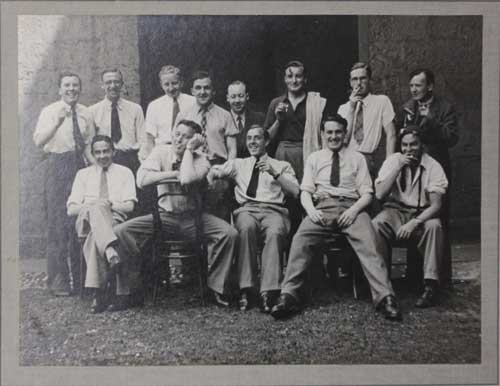Doctors
Doctors at Dr Steevens’ Hospital.
From 1733 until its closure in 1987 Dr Steevens’ Hospital was associated with some of the most notable surgeons and physicians of Ireland. In the early period Bryan Robinson and Richard Helsham were famous Dublin physicians whose works demonstrated the impact of Newtonian theory in early eighteenth-century Dublin. These were followed by men such as William Stephens and Samuel Clossy in the eighteenth century; Abraham Colles and Thomas Wrigley Grimshaw in the nineteenth century; and Arthur Chance and Walter C Stevenson and T. P. C. Kirkpatrick and Brendan Prendiville in the twentieth century. Innovative as all these men were in their respective fields of interest, their achievements should not over-shadow those of the long line of doctors and nurses, dating back to 1733, who, like them, played such an important role in the life of Dr Steevens’ Hospital and hence in the health of the citizens of Dublin.
 Group photograph of doctors, dated 1924.
Group photograph of doctors, dated 1924.
The above photograph shows us the doctors present at Dr Steevens’ Hospital in 1924, the year T. P. C. Kirkpatrick published his magnum opus The History of Dr Steevens’ Hospital. Kirkpatrick, whose book and archive (the latter now in the Royal College of Physicians of Ireland), remains the pre-eminent historian of the hospital. His work provides us with a complete listing of the doctors who worked at Dr Steevens’ Hospital up until the year 1924 and from that listing it will be clear that there are a host of doctors whose careers deserve further exploration. Some, such as John Crampton and William James Cusack, have been tangentially referred to in other parts of this web exhibition (see the Fever and Medical School webpages respectively). Others, such as Samuel Croker-King, who was active at Dr Steevens’ Hospital in the 1780s and, indeed, wrote a short history of the hospital, have received historical attention for their work in other hospitals.
A more informal photograph of doctors, c. mid 20th century.Kirkpatick was later joined by men such as the pathologist F. S. Bourke (1895–1959), Arthur Chance and Walter C. Stevenson and these men were in turn succeeded by other leading physicians and surgeons such as Peter Gatenby (who retired to lead the United Nations medical service), David Fitzpatrick (who did so much to develop the orthopaedic unit at Dr Steevens’ Hospital in the last decades of the hospital’s existence), and Brendan Prendiville who was famous, among other things, for his work on cleft palates. While in the early 1960s Dr Steevens’ had primarily been a general hospital with orthopaedics, ENT, gynaecology and some paediatrics, it was agreed, once the hospital became part of Federated hospital group, to concentrate on two key areas of excellence: orthopaedics and plastic surgery. On the closure of the hospital in 1987 these two departments moved to the Adelaide and Meath (in the case of orthopaedics) and St James’s Hospital, in the case of the Plastics, Burns and Maxillo-facial units.
Board list of doctors’ names in the later 1980s, courtesy of Dr David Fitzpatrick.Sources
Fitzpatrick, David (2006), The Feds. An Account of the Federated Voluntary Hospitals 1961-2005 (Dublin: A. & A. Farmar).
Croker-King, Samuel (1854), A Short History of the Hospital founded by Doctor Richard Steevens, near the City of Dublin, from its establishment in the year 1717 to the present time 1785 (Dublin).
Kirkpatrick, T. P. C. (1924; reprinted 2008) The History of Doctor Steevens’ Hospital Dublin, 1720-1920 (Dublin).



